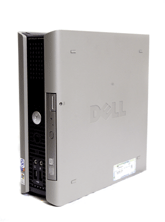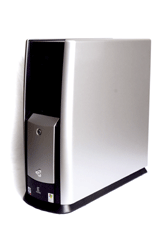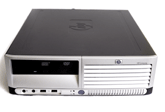A brand-new, high-performance computer suddenly died in the GCN Lab this summer and messed up our reviews schedule.We'd planned to bring you our annual desktop PC review in June, featuring the new Intel 915 G/P and 925X Express chip sets formerly code-named Grantsdale and Alderwood.MPC Computers LLC had sent us a prototype to test, and its initial benchmarks were a smashing success. The faster bridge to so-called D memory speeded up applications more than we had expected. Then the system refused to boot.It turned out there was a flaw in some of the new chips. Apparently the insulation between layers prevented vertical communication inside. Our test system stopped working.Other PC makers apparently had the same experience and backed out of our schedule. Even now, vendors such as MPC and IBM Corp. reportedly have not been able to get their new systems working reliably.Gateway Inc. elected to send its highest-end desktop with an earlier-generation chip set. Dell Inc., Hewlett-Packard Co. and Sony Corp. sent systems with the new chip.As of late July, here are the fastest, best-performing desktops you can buy that are free of the boot chip flaw.The Sony Vaio VGC-RA801G is a dream of a machine. At first we wondered about a huge, square hole through the middle of the case. But no one had used the Vaio for target practice. The hole is part of an ingenious venting system to cool the hot-running new chip set.Air flows in from both sides of the case, sucked by a huge fan that looks like part of a building's ductwork. Some of the air exits through the power supply and out the back. Some cools the chip before passing out through a different exhaust port. You'd think the setup would be as noisy as a Harley-Davidson motorcycle, but in fact it is one of the quietest desktop systems we've almost never heard.Even with the case open, you have to lean close to hear it humming slightly. That's excellent engineering.[IMGCAP(2)] It would be irrelevant, however, if the system did not perform well. The Vaio blew away pretty much everything else we have ever tested. It broke the unprecedented 9,000 mark on the lab's benchmark suite from Alterion Corp. of Conshohocken, Pa.'a testament to the 3.4-GHz chip. The actual score was 9,643.Our test unit packed a 230G hard drive, 1G of RAM and an ATI X600XT graphics card that took full advantage of the new chip set's enormous bus transfer rates.One of our benchmark tests spins a superhero-style 3-D man around on-screen while the program measures rendering speed. On the Vaio, the little superhero spun so fast I could hardly tell his head from his feet. I doubt there is any program this system can't handle, no matter how graphically intense.In front, hidden under panels, are three USB ports plus FireWire, S-Video and standard video ports, and microphone and headphone jacks. Digital camera users will appreciate other ports for CompactFlash, SecureDigital, Sony memory stick and xD Picture Card media. There's also a floppy drive and DVD-ROM and a DVD+/- rewritable drive. Around back are five more USB ports, a cable jack, more video inputs and outputs for multiple speakers.The system costs more than others in this review'$2,134 as configured for our tests. If your agency ordinarily pays about $2,000 for a high-end desktop system, that's not too bad a price.It kept us from giving the Vaio an A+, but not from awarding a Reviewer's Choice designation. The Sony combines the best performance we have yet seen with solid engineering and lots of convenience.The Dell OptiPlex GX280 spreads its wings, unlike most of the OptiPlex line that trades bleeding-edge performance for stability.[IMGCAP(3)] The GX280's blazing speed earned an excellent score of 8,471 on the lab's benchmarks, higher than any system we have tested except for the Vaio above. Our test system had 512K of RAM, 150G hard drive and ATI Radeon X300 graphics card. At $1,863, it is a firecracker.The clamshell case was easy to open, but the front-side USB ports were awkwardly placed under a plastic flap.If the system is located near the floor, plugging in a USB cable is tough. There are two ports, but close to each other and at an odd angle, so it's difficult to connect to more than one simultaneously.Aside from USB crowding, the GX280 gave great performance at a good price. It earned an A- grade and our second Reviewer's Choice designation.The Hewlett-Packard Compaq dc7100 has the second-most compact size in the review, making it ideal for cramped desks. Unfortunately, its chassis design makes maintenance cumbersome.Just large enough to accommodate a monitor, the 6.6- by 17.8- by 17.6-inch chassis opens like a briefcase when a button on either side is pushed. But the top portion slides off toward the user instead of away.That motion, combined with a slick metallic finish, made it the hardest PC in the review to open.Once under the hood, an administrator would have little difficulty reaching the powerful, 3.2-GHz Pentium 4 processor and 512M of second-generation, double-data-rate RAM. But installing a new hard drive might be difficult because the cable that connects it to the motherboard has to run under the optical drive.Although the optical drive slides forward for moving the cables, there's little elbow room and many other cables to complicate the connection. After the optical drive slides out of the chassis, locking it back takes a firm slap.The power supply moves more easily than the optical drive and rotates out of the inner chassis. The problem with this particular design is that the power supply doesn't lock into place but sits loosely inside the chassis. That normally wouldn't be a problem because when the top is properly on, it secures the power supply.Putting the top back on, however, is almost as difficult as taking it off. Once when we thought we had the top on, we turned the PC on its side. The top came off and the power supply pulled loose.Chip set, processor and RAM, together with a 75G hard drive and embedded Intel 82915 Express video card, earned the HP Compaq dc7100 a respectable third place on the Alterion benchmark. Its average of 6,633 was 21 percent lower than the OptiPlex GX280.One very good thing about the dc7100 is its array of eight well-placed USB 2.0 ports, two up front and six in back. It also has serial and parallel ports as well as PS/2 ports for mice and keyboards.Our review system had a DVD/CD-rewritable combo drive but no floppy drive, although there was room for one under the optical drive.The dc7100's most aggressive feature is its government price of $1,349. It earned a B+ and a Bang for the Buck designation.Through every test, the Dell OptiPlex SX280 ran neck and neck with the HP Compaq dc7100. Both machines are targeted to the user who needs a powerful but small desktop system. Dspite the similar benchmark scores, Dell took a noticeably different approach to compact computing.[IMGCAP(4)] It is easy to open the 3.5- by 9.8- by 10.3-inch frame. An ingenious, built-in key unlocked and opened the chassis. We hope that Dell will more clearly show which side panel comes off, since both sides look alike.Inside the box, Dell took full advantage of small Serial ATA cables and PCI Express video cards. Despite the lack of room, components still have tool-free access.The optical drive is internally inaccessible but can be swapped from the outside like the optical drives on some Dell notebooks.The SX280 has two USB 2.0 ports in front and five in back. Dell does not provide a standard analog video port but rather the digital video counterpart. The SX280 lacks PS/2 ports but has serial and parallel connections.In performance, the SX280 and the dc7100 were nearly identical. They averaged 6,352 with only a 4 percent difference between them, likely caused by the Dell SX280's 3-GHz Pentium 4 processor as opposed to the 3.2-GHz processor in the HP Compaq dc7100. The other internal components are identical, including RAM and video memory.The SX280 costs $1,628, but for the extra bucks you get a 150G hard drive, double the size of the dc7100's 75G drive.Although Gateway was the only vendor to submit an older version of the Pentium 4 chip set, its lower benchmark score was not the only reason the Gateway E-6100 HX got the lowest grade.Although the Gateway chassis is easy to access without tools, the tower measures 8 inches thick, 20 inches deep and 20.5 inches tall. Few office users can spare that much desk room.The huge size, coupled with a score of 5,732'41 percent lower than the leader'earned a C+ in the review even though the Gateway is the least expensive system at $1,186.On the plus side, the big tower has seven expansion slots for PCI cards, seven USB 2.0 ports of which two are in front, and all the other features found in the HP dc7100.The 3.2-GHz Pentium 4 processor is backed by 512M of DDR-RAM, an Nvidia GeForce FX 5200 video card and a 75G hard drive, surprisingly small for such a large machine. If you have more space than cash, the Gateway will give you high performance for not too much money.
The Dell OptiPlex SX280 combines the new chip set with a compact chassis.
Henrik G. de Gyor
Dell's GX280 has the standard OptiPlex chassis but with smaller
Gateway's huge tower is the fastest system you can buy with the older ship set.
HP's Compaq dc7100 is one of two space-saving desktops in this review.










